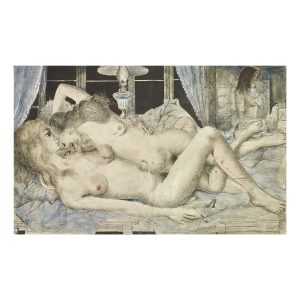Œuvres
Biographie
1897–1994
 Born in Belgium into a bourgeois family, Paul Delvaux started training as an architect at the Royal Academy of Fine Arts in Brussels in 1916.
Born in Belgium into a bourgeois family, Paul Delvaux started training as an architect at the Royal Academy of Fine Arts in Brussels in 1916.
Soon, Delvaux turned to painting which he explored under the influence of his teacher, master of Symbolism Jean Delville; he also met René Magritte, with whom he maintained a friendly relationship throughout his lifetime. During the 1920s, Delvaux worked in a style which can be defined as a Post-Impressionist interpretation of Expressionism. During the late 1920s his works featured nudes in landscapes heavily influenced by the two major exponents of Flemish Expressionism Constant Permeke and Gustave De Smet. In his quest for perfection, Delvaux was often dissatisfied and destroyed many of these paintings.
During 1933, Delvaux underwent a change of style, reflecting the influence of the Metaphysical Painting of Giorgio de Chirico, whose work he was aware of since 1927. When he saw de Chirico’s work at the Surrealist exhibition held at the legendary gallery ‘Le Minotaure’ in 1934, Delvaux decided to ‘paint poetry’ and adhered to Surrealism. The works ‘Palais en ruine’ and ‘Le Rêve’, both dated 1935, are considered his first Surrealist works. His series ‘Femmes en dentelle’ confirmed his chosen direction. Without ever officially belonging to the Surrealist movement, Paul Delvaux is considered one of its major figures. In 1938, his works were presented in Paris at the landmark ‘Exposition Internationale du Surréalisme’ organised by André Breton and Paul Éluard. Whereas his compatriot René Magritte depicted ideas, Delvaux remained singular in his fondness for narration and the theatrical, hallmarks of Symbolism.
His works depict antique ruins, imaginary architectural constructions or contemporary city structures against deserted and mysterious landscapes haunted by inaccessible female figures.
The skeletons he saw at the Brussels Museum of Natural History made an appearance in many of his paintings and contributed to create a strange and fantastic universe.
During the 1930s Delvaux was commissioned large murals for the Ostend Casino and for the ‘Palais des Congrès’ in Brussels, which earned him great respect. In 1956 Delvaux represented Belgium at the 27th Venice Biennale where his scenes of the ‘Passion of Christ’, populated with skeletons, caused a scandal; in 1961, the ‘Musée des Beaux-Arts’ of Lille hosted his first retrospective ; in 1975, a large retrospective was held in his honour at the Tokyo National Museum of Modern Art. In 1982 the Paul Delvaux Museum opened Saint-Idesbald on the Belgian Coast. Delvaux died in Saint-Idesbald in 1994.


